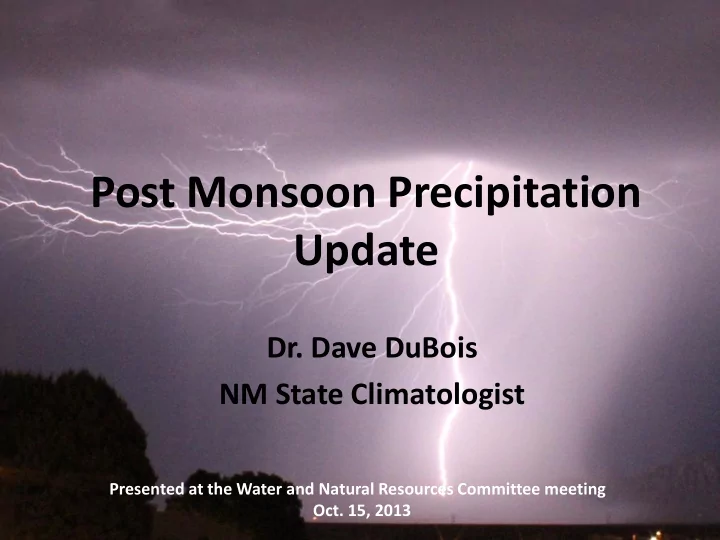

Post Monsoon Precipitation Update Dr. Dave DuBois NM State Climatologist Presented at the Water and Natural Resources Committee meeting Oct. 15, 2013
July-September Precipitation Percent of Normal “The Monsoon” Majority of locations >100% of normal 3 locations over 200% of normal
Las Cruces (NMSU) 2013 Precipitation • Above normal for monsoon, b elow for the year 111% of normal for monsoon (July-Sept) 75% of normal for 2013 63% of normal for water year that just ended 2.83” in early Sept. provided a big boost in 2013 79 day dry spell from Feb. 20 to May 10 Source: ACIS
2013 Temperatures at NMSU Average September temperature +1.1°F above normal (normal based on 1981-2010) Average 2012 JAS temperature +2.2°F warmer than 20 th century average
You know things are going to be interesting when you see a forecast map like this Issued Sept. 10
and with total atmospheric moisture at the 99 th percentile
Year to date at a few locations as of Oct. 11 YTD total Deviation from From Sept * Station precip (in) normal (in) storm (in) * Storm PORTALES 16.92 2.05 3.43 Sept. 9-16 HOPE 13.99 1.61 5.58 LOS LUNAS 3 SSW 9.51 1.48 1.97 ALBUQUERQUE INTL AP 7.94 0.15 3.14 DEMING MUNI AP 9.31 -0.01 3.02 GALLUP MUNI AP 9.28 -0.05 1.59 RIO RANCHO #2 8.93 -0.57 3.17 LAS VEGAS MUNI AP 15.31 -0.63 6.23 HILLSBORO 10.33 -0.76 5.37 MORIARTY 1 NE 10.45 -0.88 4.24 CLAYTON MUNI AIR PK 12.69 -1.61 4.05 CARLSBAD 9.63 -1.66 2.64 STATE UNIV 5.99 -1.90 2.83 ROSWELL IND AIR PK 8.34 -2.58 3.57 ROSWELL CLIMAT 9.90 -3.16 3.76 OCHOA 8.60 -3.20 0.01 TUCUMCARI MUNI AP 11.01 -3.96 3.04 TATUM 10.42 -4.41 0.15
Guadalupe Mountains Mapped as it was happening on Sept. 12 15.84 inches by end of week
Statewide June-August Temperature 2013 summer was 7 th warmest on record 2013 colored line is 5-year moving average
US Drought Monitor Drought classification puts drought in historical perspective DM Level Name Frequency D0 Abnormally dry 3-5 years D1 Moderate drought 5-10 yrs D2 Severe drought 10-20 yrs D3 Extreme drought 20-50 yrs D4 Exceptional drought 50-100 yrs
State-wide NM Drought Monitor • Drought impacts started in late 2010 with occurrence of D2
Corona, NM (Adams Ranch SCAN station) 8” soil moisture
Elephant Butte as of 10/14/13 Current Storage 169,373 acre-ft Capacity 2,195,000 acre-ft Storage on 7/8 60,327 acre-ft 7.7% of capacity Photo from August 29, 2013
Elephant Butte Reservoir The July date was about the minimum storage for the year after the irrigation. June 6, 2013 July 8, 2013 I find it amazing what one month of about 2000 cubic feet per second flow out of the reservoir can do to the appearance of the lake.
Forecast - ENSO-neutral is expected through Spring 2014 Seasonal Predictions Many models predict a gradual increase from slightly cooler than average to warmer conditions as the spring approaches http://www.cpc.ncep.noaa.gov/products/analysis_monitoring/enso_advisory/ensodisc.html
Seasonal Forecast Neutral ENSO conditions most likely through the rest of the year http://iri.columbia.edu/climate/ENSO/currentinfo/figure3.html
Oct – Dec Precipitation Outlook http://www.cpc.ncep.noaa.gov/
Oct – Dec Temperature Outlook http://www.cpc.ncep.noaa.gov/
http://www.cpc.ncep.noaa.gov/
Outlook based on past wet monsoons • Considering the wettest monsoons with anomalies >2” over the long -term average • Let’s look at how the following winters (Dec to Feb) behave in terms of precipitation • Long term averages are based on data from 1901 to 2000 • Wettest state-wide monsoons with anomalies >2” were in 2006, 1991, 1990, 1988, 1972, 1941, and 1929
Outlook from past wet monsoons • During those very wet monsoon years we tend to have slightly wetter winters in southern NM compared to the north • In the northern climate zones there is very little change compared to the mean • Overall, there is not a strong tendency for wet a winter but at least it doesn’t show drier than long-term average
Contact Dr. Dave DuBois NMSU State Climatologist dwdubois@nmsu.edu http://weather.nmsu.edu Twitter @nmclimate www.youtube.com/nmclimate
Recommend
More recommend